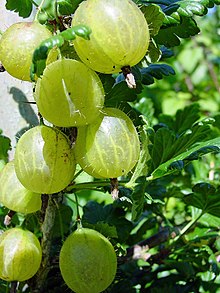Gooseberry
From Wikipedia, the free encyclopedia
This article is about the plant in the genus Ribes. For other uses and unrelated species, see Gooseberry (disambiguation).

| Ribes uva-crispa Gooseberry | |
|---|---|
| Cultivated Eurasian gooseberry | |
| Scientific classification | |
| Kingdom: | Plantae |
| (unranked): | Angiosperms |
| (unranked): | Eudicots |
| (unranked): | Core eudicots |
| Order: | Saxifragales |
| Family: | Grossulariaceae |
| Genus: | Ribes |
| Species: | R. uva-crispa |
| Binomial name | |
| Ribes uva-crispa L. | |
The gooseberry (pron.: /ˈɡuːsbɛri/ or /ˈɡuːzbɛri/ (American) or /ˈɡʊzbəri/ (British);,[1] with scientific names Ribes uva-crispa (and syn. Ribes grossularia), is a species of Ribes (which also includes the currants). It is native to Europe, northwestern Africa, west, south and southeast Asia. Gooseberry bushes produce an edible fruit and are grown on both a commercial and domestic basis.
Although usually placed as a subgenus within Ribes, a few taxonomists treat Grossularia as a separate genus, although hybrids between gooseberry and blackcurrant (e.g., the jostaberry) are possible. The subgenus Grossularia differs somewhat from currants, chiefly in their spiny stems, and in that their flowers grow one to three together on short stems, not in racemes. It is one of several similar species in the subgenus Grossularia; for the other related species (e.g., North American Gooseberry Ribes hirtellum), see the genus page Ribes.
Culinary uses
| Nutritional value per 100 g (3.5 oz) | |
|---|---|
| Energy | 184 kJ (44 kcal) |
| Carbohydrates | 10.18 g |
| - Dietary fiber | 4.3 g |
| Fat | 0.58 g |
| Protein | 0.88 g |
| Water | 87.87 g |
| Vitamin A equiv. | 15 μg (2%) |
| Thiamine (vit. B1) | 0.04 mg (3%) |
| Riboflavin (vit. B2) | 0.03 mg (3%) |
| Niacin (vit. B3) | 0.3 mg (2%) |
| Pantothenic acid (B5) | 0.286 mg (6%) |
| Vitamin B6 | 0.08 mg (6%) |
| Folate (vit. B9) | 6 μg (2%) |
| Vitamin C | 27.7 mg (33%) |
| Vitamin E | 0.37 mg (2%) |
| Calcium | 25 mg (3%) |
| Iron | 0.31 mg (2%) |
| Magnesium | 10 mg (3%) |
| Manganese | 0.144 mg (7%) |
| Phosphorus | 27 mg (4%) |
| Potassium | 198 mg (4%) |
| Sodium | 1 mg (0%) |
| Zinc | 0.12 mg (1%) |
| Link to USDA Database entry Percentages are relative to US recommendations for adults. Source: USDA Nutrient Database | |
Gooseberries are often used as an ingredient in desserts, such as pies, fools and crumbles. They are also used to flavour beverages such as sodas,flavoured waters, or milk, and can be made into fruit wines and teas. Gooseberries can be preserved in the form of jams, dried fruit, or as the primary or a secondary ingredient in pickling, or stored in sugar syrup.
[edit]Etymology
The "goose" in "gooseberry" has usually been seen as a corruption of either the Dutch word Kruisbes or the alliedGerman Krausbeere, or of the earlier forms of the French groseille. Alternatively the word has been connected to theMiddle High German krus (curl, crisped), in Latin as grossularia. However, the Oxford English Dictionary takes the obvious derivation from goose and berry as probable because "the grounds on which plants and fruits have received names associating them with animals are so often inexplicable that the inappropriateness in the meaning does not necessarily give good grounds for believing that the word is an etymological corruption." It is also perhaps worth noting that the French for gooseberry is groseille à maquereau translated as 'mackerel berries'.[6]
"Gooseberry bush" was 19th-century slang for pubic hair, and from this comes the saying that babies are "Born under a gooseberry bush."[7]
The specific epithet uva-crispa literally means "curved grape".[8]

No comments:
Post a Comment